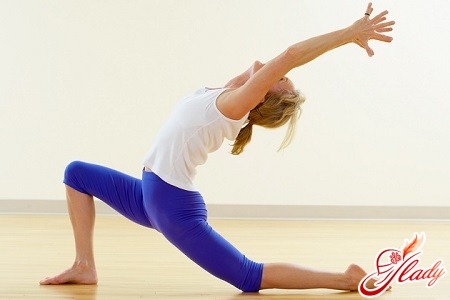 Breathing exercises for asthma - thingpractically irreplaceable. The purpose of breathing exercises is simple - to improve the well-being of a sick person, as well as to prevent the development of complications. And with bronchial asthma, breathing exercises are especially useful. Exercises, of course, will not rid you of the disease completely, but will significantly ease the course of the disease. Breathing exercises require regular practice, since only by following a certain schedule can you achieve good results and positive dynamics. To be effective, the exercises must be performed in a well-ventilated room, and in the warm season - in the fresh air.
Breathing exercises for asthma - thingpractically irreplaceable. The purpose of breathing exercises is simple - to improve the well-being of a sick person, as well as to prevent the development of complications. And with bronchial asthma, breathing exercises are especially useful. Exercises, of course, will not rid you of the disease completely, but will significantly ease the course of the disease. Breathing exercises require regular practice, since only by following a certain schedule can you achieve good results and positive dynamics. To be effective, the exercises must be performed in a well-ventilated room, and in the warm season - in the fresh air.
The main complex
Relieving stress and tension associated withan attack of bronchial asthma, as well as preventing attacks - this is the primary goal of this set of breathing exercises. And if you are just starting to master gymnastics, start with them.
- Exhalation through the mouth
Still in bed, right after we woke up,you can do the first exercise. Bend your legs at the knees and try to pull them up as much as possible while simultaneously exhaling for a long time through your mouth. This exercise should be repeated as many times as you think necessary, since during the exercise the phlegm is removed, the airways are cleared and breathing becomes freer.
- Alternate breathing
This exercise does not require any special conditions -it can be done both standing and sitting. It consists of breathing first through the right and then the left nostril. Close the left nostril with your fingers, inhale, close the right nostril - exhale. Then, accordingly, vice versa.
- Diaphragmatic breathing
Place your hands on your waist, inhale through your nose, inflating your stomach as much as possible. Then exhale sharply through your nose and pull in your stomach.
- Deep ventilation
This exercise is performed in a sitting position,hands on knees. Inhale - arms to the sides, exhale - pull the left knee to the stomach with your hands. Repeat the exercise, pulling the right knee accordingly. Another exercise that helps improve ventilation can only be done by those patients whose asthma is not severe. To perform the exercise, take the starting position - lean your hands on the seat of the chair. Inhale - arch your back, bring your shoulder blades together, exhale - bend your legs and pull your knees to your chest!
- Intermittent breathing
Although this exercise is quiteeffectively, it should not be done by people who, in addition to bronchial asthma, also suffer from hypertension. The exercise is simple - you need to inhale air through your nose - sharply, counting "one, two, three." Then exhale through the sounds "sh", "z".
- Exercises that improve the condition of the bronchi
Inhale – rise up on your toes, raise your armsFirst on the sides, at chest level, and then up.. Actions in reverse order - exhale! The next exercise is performed in a standing position, arms freely along the body. Inhale - tilt the body to the side. Exhale - starting position. The "Lumberjack" exercise is familiar to everyone from childhood: standing, hands in a lock. Hands rise up - inhale. Hands down, respectively, exhale with the sound "oof" or "uh". Or another option - hands along the body. Inhale for 4 counts, raising the shoulders. Exhale for 4 counts - while doing this, do not forget to lower and relax the shoulders. Standing, bend your arms at the elbows - keep them near the body. Spread your elbows to the sides, inhale through your nose - hold the air for a few seconds. Exhale with the sound "sh", bring your elbows together as much as possible and pull your stomach in. Take a deep breath, and on the exhale pronounce the sounds "a", "o", "u" and simultaneously tap on the lower ribs - first in front, then in the back.
Gymnastics of yogis
Indian yogis have developed their own method of exercises for the treatment of bronchial asthma.
- Oxygen saturation
Sitting on the floor, take the lotus position:right leg - on the left thigh, left leg - on the right thigh. Palms on the thighs at their sides. Straight spine. The pose can be in a simplified version: just sit on the floor and cross your legs (Turkish style). The gaze is fixed on the tip of the nose, and the tongue is pressed to the base of the front teeth. After taking a comfortable position, inhale and exhale - 8 times, then take a deep breath and try to hold your breath for at least 5 seconds. Then comes a slow exhalation. The exercise should be repeated three times, alternately exhaling through both nostrils. It should be stopped early if signs of tension appear.
- Cleansing Breath
The exercise "cleansing breath" is simply irreplaceablewhen fighting bronchial asthma. Standing with your feet shoulder-width apart, take a slow, noisy breath through your nose so that the wings touch the septum. Then, pursing your lips, without puffing out your cheeks, begin to exhale air in small portions. You need to exhale strongly - you should feel the tension in your abdominal muscles, ribs and diaphragm. If you exhale weakly and softly, the exercise loses its meaning.
- Relaxation
Standing with your feet shoulder-width apart, inhaleas in the previous exercise, and on the exhale slowly raise your arms above your head, then hold your breath for a few seconds. Then bend forward sharply, lower while exhaling through your mouth - at this moment pronounce the sound "ha" by blowing out air, without using your vocal cords. Straighten up with a slow exhale, raise your arms above your head tensely, and relax while exhaling, slowly relaxing your arms.
- Stimulation of lung function
Lie down on your back and dodeep breath, as in the previous two exercises. At the same time, you need to start raising your arms up until they touch the floor above your head. Then hold your breath for a few seconds, then lift your legs, sharply bending your knees. Grasping your legs with your arms, press your hips to your stomach and simultaneously exhale air with the sound "ha". Rest for a few seconds in this position. After resting, take a slow breath, during which you raise your arms above your head, straighten and lower your legs to the floor. After a few seconds, exhale slowly through your nose, lowering your arms. After a full cycle of movements and breathing of this exercise, which takes about 20 minutes in total, you should give yourself a complete rest.
Tibetan gymnastics
The set of exercises developed and proposed by Tibetan yogis is one of the most effective in the world both in the prevention of bronchopulmonary diseases and in the fight against them.
- Cleansing the lungs
The starting position for this exercise is standing,feet shoulder-width apart. On a slow inhale, begin to raise your arms above your head - eventually your palms should touch each other. After holding your breath for 5 seconds, you need to slowly exhale, simultaneously lowering your arms down, while straining your diaphragm and abdominal muscles. If the previous exercise is physically difficult for you, pay attention to this. During a full slow inhale, stretch your arms forward, palms down, at shoulder level. Then hold your breath. While holding your breath, you need to spread your arms horizontally to the sides and bring them together in front of you three to five times. After the intended series of hand movements, you need to exhale deeply through your mouth.
- Oxygen saturation
Stand with your feet shoulder-width apart.Then stretch your arms forward to shoulder level, palms facing inward. Inhale very deeply and smoothly, hold your breath - at this time you need to quickly make vertical circles with your arms 3 times in both directions. Then exhale vigorously, lower your arms and rest a little. Starting position - lying on your stomach on the floor, palms of your hands under your shoulders. Take a full breath, hold your breath, slowly straighten your arms and raise your body, resting on your toes and hands. In practice, the exercise is similar to push-ups from the floor lying down, but supplemented by an energetic exhalation through the mouth. Finish the exercise with a complex of "cleansing breath". Stand straight, turn to face the wall, lean your hands against the wall, while keeping your palms very wide apart. Exhale completely, hold your breath for a couple of seconds, relax as much as possible. In this position, bend your arms at the elbows until you touch the wall with your forehead. Then push off the wall with force - you should stand up straight. You need to repeat the exercise at least several times.
- Help Your Bronchies
The starting position for this exercise is -Standing, feet shoulder-width apart, hands on hips. Take a deep breath and hold it for a few seconds. Next, you need to slowly bend forward while exhaling through your mouth. Then straighten up again, inhale again, then hold your breath and bend back. Note - everything must be done slowly. The same movements should be repeated to the right and left sides. After all the movements, you need to pause your breathing, then exhale through your nose and slowly lower your arms. If asthma attacks have become too frequent, you should try the following exercise - stand straight, place your feet shoulder-width apart, slowly take a deep breath, filling your lungs with air through pauses. Then hold your breath for 10 seconds, and then slowly inhale through your nose.
Gymnastics Strelnikova
Since breathing exercises have a verymany varieties, then it is also worth dwelling in detail on the program of A.N. Strelnikova. Strelnikova's method has been successfully used for a long time to treat asthma. Its effectiveness has been proven by the results of classes attended by many patients who could hardly withstand attacks of suffocation. Without exception, everyone noted a significant improvement in their condition after just a few days. So, the complex consists of a group of exercises that can be easily performed by anyone - no special physical training is required. Most of the exercises from this group require inhalation with a compressed chest - it is with their help that you can stop attacks of suffocation characteristic of bronchial asthma. And in addition, you can cure not only asthma, but also chronic bronchitis. Moreover, pay special attention to the exercise "pump" - it not only ensures the prevention of attacks, but can also relieve an attack that has already begun. Therefore, work on this exercise in advance so that you can repeat it without problems at the right moment. When feeling a sense of suffocation or during an attack, the sick person should sit up straight, rest his hands on his knees and perform the "Pump" exercise with a series of 2-4 short breaths through the nose. Note - you cannot lean back or straighten up too much.
- Exercise "Pump"
A rolled up newspaper or stick is taken in the hands aspump handle and depict pumping up a car tire. Tire tilt - inhale, straighten - exhale. Without straining, tilts and straightens are performed easily and often. The head is slightly tilted, as if looking at an imaginary pump. Do not bend below the waist. Inhale through the nose, exhale - through the mouth, the back is round, the head is lowered. The rhythm of "inflating the tire" resembles the rhythm of a marching step. You need to take at least 8 breaths in a row. Then there is a rest of about 5 seconds, and then you need to repeat 10 breaths-movements. By the way, this exercise is recommended not only to stop asthma attacks, but also heart attacks and hepatic colic. It can be done standing or sitting.
- "Bends"
The following exercise is extremely effective.prevention of attacks. This exercise is performed as follows - slightly lean forward - head down, arms bent at the elbows. noisy short breath in through the nose. Straighten up slightly, not completely, maintaining the same position - exhale. Repeat from the beginning. After two breaths-movements, rest for a few 3-7 seconds and repeat two breaths-movements or four breaths-movements (similar to a bow) in a row. And again alternate, a series of breaths-movements, rest, and again.. There is no need to count the number of series of breaths-movements. The exercise is repeated until you feel slight fatigue. The only count that is kept is the number of breaths in a series, two or four. The exercise, as a rule, can be performed for 10-15 minutes. If the attack is very severe and it is difficult for the patient to inhale while bending over, it is quite acceptable to sit down. The body should be tilted forward, the head should be lowered freely, the elbows should be placed on the knees and the back should be rounded. Without performing any movements, it is necessary to noisily inhale through the nose twice (sniff). It is recommended to rest for a few seconds after each two inhalations, without moving. It is necessary to remember that in this exercise there is an exhalation, but it is very imperceptible. Exhale quietly and calmly. The inhalation is done to the full depth of the lungs, the feeling of inhalation is almost in the back, in the lower back.
- "Hug your shoulders"
Raise your arms, bent at the elbows, to levelshoulders. The palms facing you should be placed in front of the chest, at neck level. The hands are thrown sharply towards each other as if towards each other, but at the same time one touches the opposite shoulder, and the other to the opposite armpit - they move parallel to each other. If the exercise is performed on the move, then you need to maintain the rhythm of the steps. Inhalations, short and noisy, are repeated simultaneously with each "embrace". As you already understood, the two main exercises that underlie all the others are the bend-inhalation, simultaneously, briefly and sharply; embrace-inhalation, rhythmically and repeatedly. When performing exercises according to Strelnikova's method, it will not be superfluous to master the following practices:
- Learning to breathe
Do you want to understand how to inhale correctly?Imagine that the apartment smells of burning. And you need to act according to the imaginary situation - that is, sniff, sniff, noisily, sharply, sniff the air throughout the entire apartment.
- We exhale
Every exhalation should be a consequence of an inhalation.Each exhalation should be natural, after each inhalation, and it is better if the exhalation is through the mouth, not through the nose. Do not strain. Think only: "It smells like burning! Alarm!" Attention should be focused only on the inhalation, the exhalation should happen on its own. The mouth should be kept slightly open, this helps breathing exercises.
- Watching the pace
It will be better if during your inhalations you becomementally hum a rhythmic melody, "pumping up the tire" In the process, you need to count the breaths-movements. The rate of breaths-movements is 60-72 per minute. Inhale loudly, exhale quietly. The norm is 100-200 breaths. Pauses between reprises of breaths are 1-3 seconds. During the exercises, you need to take as many breaths as the condition of the patient with bronchial asthma allows. If the exercises do not help to normalize breathing, then you need to use the usual medications to stop attacks of suffocation in bronchial asthma. On the day of an attack, you cannot continue exercising.









